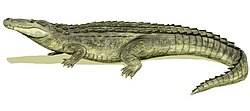| Lianghusuchus Temporal range: Eocene, | |
|---|---|
| Scientific classification | |
| Domain: | Eukaryota |
| Kingdom: | Animalia |
| Phylum: | Chordata |
| Class: | Reptilia |
| Clade: | Archosauromorpha |
| Clade: | Archosauriformes |
| Order: | Crocodilia |
| Family: | Alligatoridae |
| Genus: | † Lianghusuchus Young, 1948 |
| Type species | |
| †Lianghusuchus hengyangensis Young, 1948 | |
Lianghusuchus is an extinct monospecific genus of crocodilian. Fossils date back to the Eocene and have been found from Hunan, China. [1] The type species is Lianghusuchus hengyangensis, named in 1948. [2] It was originally considered a crocodile belonging to the family Crocodylidae, but was later considered a member of the alligator family Alligatoridae in a 1999 phylogenetic study by Christopher Brochu. [3]


